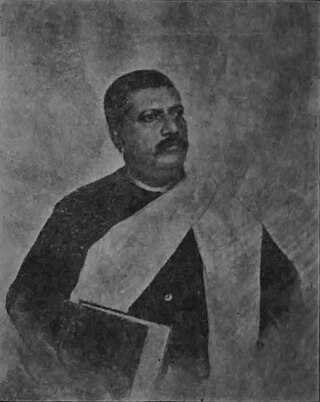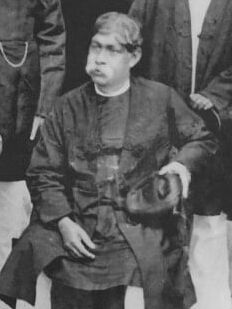
Bhawal Estate was a large zamindari in Bengal (in modern-day Gazipur, Bangladesh) until it was abolished according to East Bengal State Acquisition and Tenancy Act of 1950. [1] [2] This

Bhawal Estate was a large zamindari in Bengal (in modern-day Gazipur, Bangladesh) until it was abolished according to East Bengal State Acquisition and Tenancy Act of 1950. [1] [2] This
In the late 17th century, Daulat Ghazi was the zamindar of the Ghazi estate of Bhawal. Bala Ram was Diwan of Daulat Ghazi. In 1704, as the consequence of change in the policy of revenue collectionm, Bala Ram's son Sri Krishna was installed as the zamindar of Bhawal by Murshid Quli Khan. Since then, through acquisitions the zamindari expanded. The family turned into the proprietor of the whole Bhawal pargana after purchasing the zamindari of J. Wise, an indigo grower for Rs 4,46,000. [2]
In 1878, British Raj conferred Raja title to Zamindar Kalinarayan Roy Chowdhury. [2] His son Raja Rajendra Narayan Roy Chowdhury extended the zamindari. Rajendra was married to Rani Bilasmani Devi. They had 3 daughters - Indumayi, Jyotirmayi and Tarinmayi, and 3 sons - Ranendra Narayan, Ramendra Narayan and Rabindra Narayan. [2] [3] Writer Kaliprosanna Ghosh was appointed the Dewan of Bhawal Estate for Rajendra Narayan. [4] Rajendra died in 1901. [2]
The estate comprised over 1,500 square kilometer, which included 2,274 villages and around 55,000 villagers. [5] Its biggest establishment is the Bhawal Rajbari palace. [5] Bhawal Temple and Shoshan Ghaat (cremating area) are situated to the south of the palace. [5]
| Part of a series on |
| Zamindars of Bengal |
|---|
 |

Meer Syed Mosharraf Hossain was a Bengali writer, novelist, playwright and essayist. He is considered to be the first major writer to emerge from the Muslim society of Bengal, and one of the finest prose writers in the Bengali language. His magnum opus Bishad Sindhu is a popular classic among the Bengali readership.
Mohammad Yakub Ali Chowdhury was a Bengali essayist and journalist. He was noted as one of the few Bengali Muslim literary scholars of his time.

Dhaka (Dacca) is a modern megacity with origins dating to circa the 7th century CE. The history of Dhaka begins with the existence of urbanised settlements that were ruled by the Hindu Gauda Kingdom, Buddhist and Shaivite Pala Empire before passing to the control of the Hindu Sena dynasty in the 10th century CE. After the Sena dynasty, the city was ruled by the Hindu Deva Dynasty.

Hakim Habibur Rahman was an Unani physician, litterateur, journalist, politician and chronicler in early 20th-century Dhaka.

Nāsir ad-Dīn Naṣrat Shāh, also known as Nusrat Shah, was the second Sultan of Bengal belonging to the Hussain Shahi dynasty. He continued with his father's expansionist policies but by 1526, had to contend with the Mughal ascendency in the Battle of Ghaghra. Simultaneously, Nasrat Shah's reign also suffered a reverse at the hands of the Ahom kingdom. The reigns of Alauddin Husain Shah and Nasrat Shah are generally regarded as the "golden age" of the Bengal Sultanate.
Ruknuddīn Bārbak Shāh was the son and successor of Sultan Nasiruddin Mahmud Shah. Initially appointed as the governor of Satgaon during the reign of his father, Barbak ascended the throne of the Bengal Sultanate in 1459. He was the first ruler to give prominent roles in the Sultanate's administration to the Abyssinian community. Historian Aniruddha Ray credits Barbak Shah as the pioneer of urbanisation in Bengal.
Musa Khan was the leader of the Bara-Bhuiyans of Bengal following the death of his father, Isa Khan.
Shāhzāda Bārbak, known by his regnal title as Ghiyāsuddīn Bārbak Shāh, was the Sultan of Bengal in 1487 and the founder of the Sultanate's Habshi dynasty. He was a former commander of the palace-guards of Jalaluddin Fateh Shah court.

Mohammad Mozammel Huq was a Bengali-language poet, novelist, magistrate and educationist. His writings were said to have been inspired by a "Muslim renaissance".
Nawab Bahadur was a title of honour bestowed during Mughal Empire and later during British Raj to Indian Muslim individuals for faithful service or acts of public welfare.
Masum Khan was a zamindar of Bengal. He was the eldest son and successor of Baro-Bhuiyan leader Musa Khan and the grandson of Isa Khan.
Ashrafuddin Ahmad Chowdhury was a Bengali politician who had served as general secretary of the Congress Party's Bengal branch, member of the East Bengal Legislative Assembly and later as the Education Minister of Pakistan. He was an advocate of Huseyn Shaheed Suhrawardy's United Bengal proposal.

Rai Bahadur Dewan Kaliprosanna Ghosh, CIE Vidyasagar was a Bengali journalist, writer and scholar.
The Kohinoor was a Bengali language newspaper, first published in July 1898. Initially focusing on miscellaneous topics such as Islamic culture, its third relaunch was a pivot of Hindu-Muslim harmony. The paper targeted both Hindu and Muslim clientele.

Tanda, also known as Tandah and Khwaspur Tandah, was a historic 16th-century city of Bengal in the eastern part of South Asia, and one of the most prominent medieval capitals; serving the Karrani Sultans of Bengal and the early Mughal governors of Bengal.

The Greater Jessore region predominantly includes the districts of Jessore, Jhenaidah, Narail and Magura in Bangladesh, as well as the Bangaon subdivision of India. Nestled close to the Sundarbans, the region experienced human settlement early on. It served as the capital city of the Samatata realm and passed through several Buddhist and Hindu kingdoms such as the Palas and Senas. Jessore was ruled by Khan Jahan Ali of Khalifatabad, under the Muslim Sultanate of Bengal, who is credited with establishing the Qasbah of Murali and urbanising the region through advancements in transportation and civilization. Jessore later came to be ruled by various chieftains such as Pratapaditya and became familiar to contemporary European travellers as Chandecan before being annexed to the Mughal Empire in the seventeenth century. By 1757, the British East India Company had dominated and started to establish themselves in the region. British rule lasted up until 1947, with Jessore coming under the Provisional Government of Bangladesh from 1971 onwards.

The zamindars of Mahipur were a Bengali aristocratic family of feudal landowners. The zamindari estate encompassed the Chakla of Qazirhat under the Cooch Behar State since the Mughal period. Although their aristocratic status was lost with the East Bengal State Acquisition and Tenancy Act of 1950, the Mahipur estate remains an important part of the history of Rangpur and belongs to one of the eighteen ancient zamindar families of Rangpur. The zamindari palace was lost as a result of flooding from the Teesta River, although the mosque, cemetery, polished reservoir and large draw-well can still be seen today.

Khwaja Hafizullah Kashmiri (1735–1815), also known as Moulavi Hafizullah, was an 18th-century merchant of Kashmiri origin. He and his nephew, Khwaja Alimullah, were the founding members of the Dhaka Nawab Estate, the largest zamindari held by any landholder in Eastern Bengal during the British colonial period.

Abū Naṣr Muḥammad Waḥīd, or simply Abu Nasr Waheed, was a Bangladeshi Islamic scholar, educationist, author and politician. He is best known for his reformations to Islamic education in Bengal, and development of Arabic language education among Bengali Muslims. Wahid also served as the Education Minister of British Assam and a member of the Assam Legislative Assembly.

Kishorilal Roy Chowdhury was a Bengali zamindar. He was a member of the Baliati Zamindari.